Poly Alumni President: Milo Strawn 817-368-9620
Written by the L. 4k and L. 4B classes of D. McRae School in 1933 and under the direction of Miss Nell Bratton
In 1852 when Fort Worth was a very small village and Poly a barren prairie covered with grass almost as tall as a man, Arch Hall and his brother-in-law, Roger Tandy, left comfortable homes in Kentucky and set out with their families and negro slaves for the wilderness of Texas. They traveled slowly in horse-drawn covered wagons. They were forced to clear their path a great part of the way, and where they found roads at all they found them so rough as to make traveling extremely difficult. Mr. Hall told of one day when the going was so slow that at night they found themselves so close to the camp of the night before that he sent his slaves back on foot to get embers from the fire to start the new camp-fire.
These pioneers brought with them plowshares, spinning-wheels, equipment for looms, molds for candles, and seeds and stock with which to begin farming. With the adze, a tool somewhat like an axe, they cut and trimmed timber with which to build log cabins. Arch Hall settled south of Tandy Lake at about the present location of 3500 Avenue E, while Roger Tandy chose a site north of the lake.
Furniture in these homes was scarce and consisted of beds, tables, and chairs, which in most cases were hand-fashioned. Logs were burned in big fireplaces for heat and cooking. Frames for looms were shaped from timbers and the work of spinning and weaving was begun. Candles were rnade of tallow in the molds brought from Kentucky. Water was hauled in barrels from a spring in a nearby creek. The tall prairie grass was cut and plowed under and the land made ready for cultivation. Oxen were used to pull the plows at first. Corn and wheat were the chief crops. The grain was ground into meal and flour by a mill at Tucker's Hill, between Poly and Fort Worth.
In 1857 Arch Hall took wagons to Jefferson County and brought back lumber with which he built a story-and-a-half house on the spot where the Leach home now stands. In 1866 W. D. Hall, who had followed his brother here in 1857, built a house of lumber brought from Jefferson County, also. This house was located at Avenue I. It burned about 1910.
When these frame houses were built, home comforts were improving. Brass lamps were used instead of candles, and stoves were used for cooking. Farm machinery was more efficient, and it was no longer necessary to weave cloth in the home, for stores in Fort Worth were able to supply the need.
Trips to Handley and Fort Worth were rare and important occasions upon which stores of supplies were laid in to last for weeks. Wagons were sent to far distant eastern towns to bring back things which could not be found near. The return of these wagons was eagerly awaited by the women and girls who longed for news of the fashions of the day.
Homes were so widely scattered that social life was limited. when a party or a dinner was held at one home the news went out by word of mouth and neighbors came from miles away to attend. The nearest church was in Fort Worth. At times religious services were held in homes when a traveling preacher happened to pass through.
The first school in this community was a subscription school located on Sycamore Creek and taught by W. D. Hall, who had been held a prisoner by the northern army during the Civil War, and had spent his time there in studying Latin In 1883, a private school was built near the Arch Hall home for the benefit of the children and tenants of the Hall and Tandy families. This school was taught by Miss Mary Young, who came from Tennessee.
About 1886, the first public school was organized. It was called District No. 42 and was taught by Miss Helen Perrin, a graduate of Vassar. A few years later a school was built in connection with the Manchester Cotton Mill which was owned by a company from England. The first Post Office was at this mill also. The Manchester School was torn down in 1906 when the Polytechnic Public School was built at Nashville, between Avenue B and Avenue C. The first trustees of this school were E. S. Hall, D. McRae, R. W. Gillespie, J.H. Price, William James, Judge Chambers, and J. S. Wilson.
In 1907 Sam Calloway became superintendent of this school. There were seven grades at frst, but a grade was added each year until 1912 when the first class was graduated. The members of this class were Chester Hollis, Bessie Hollis, Fay Boykin, Mary Brown, James Liddell, Marguerite Latimer, and five others whose names we have misplaced. This school organized the first football and basketball association and the first declama-tion league in the county. The name of the school was later changed to S.S. Dillow.
The T. and P. Railroad was the first to come to Fort Worth. For some time it stopped just north of Poly. On the day in 1876, when the first train came through, all the people went down to the tracks to see it. When it came around the bend it frightened them so that some of them turned and ran home as fast as they could.
In 1890 the Southern Methodist Conference decided to build Polytechnic College near Fort Worth. They chose the present location of the college because of the elevation of the land. Mr. Tandy and Mr. Hall gave the land for the campus and an in-terest in more land to be used in getting money for buildings. The college began with one two-story building A boy's dormitory, a gymnasium, and a chapel were added. Dr. Adkisson was the first president of the college. There were only a small number of teachers and students at first. The first graduating class was one man. Mrs. Hubert Leach graduated in 1895 and was the first person to be married in the chapel. Because the college was called Polytechnic College, the town which sprang up about it was called Polytechnic. For twenty-four years Polytechnic College was a co-educational school, but in 1914 it became a girls' school and the name was changed to Texas Wesleyan College.
In 1891 the first church was organized by Rev. C. A. Evans on the campus of the college. The first services were held in the college chapel. It was called the Polytechnic Methodist Church. In 1902 the church was moved to the new administration building. In 1909 the first church was built on the comer of Avenue F and Annis, on the campus. Rev. H. M. Long was pastor at that time. It was a brick building. It is now used by the college as a Fine Arts Building.
The Manchester Cotton Mill was the first business in Polytechnic. It was located near the end of Avenue E. When the college came here S. S. Dillow was running a store near Grapevine. In 1892 he married and moved to Poly. He built a small wooden building and installed the first grocery store. This building was at the location of the present Dillow home. In one corner of his store he kept a sub-station of the Fort Worth Post Office.
Poly's second store was Davidson's, which was sold in 1907 to the Bradford brothers who came from Mansfield. The third business was a variety store run by Mrs. Hobbs. It was in the Dillow building next to the Dillow Grocery.
In 1892, R. Vickery, Arch Hall, George Tandy, and several other Poly citizens installed street car tracks from the campus to Boaz Street in Fort Worth. The car was pulled by two mules. The mules and car were kept at night in a stall on the corner of Avenue E and Nashville. Sometimes the mules had trouble in climbing Vickery Hill and men and boys had to get out and push while the ladies rode and thought it very amusing. W. K. Gandy was the operator of the mule car. In 1897, J. K. Voss ex-tended his electric street car line from Arlington Heights to the college campus.
The last car at night was left standing at the end of the track. One Halloween, boys put the car on the campus and caused the motorman much trouble in getting -it back on the tracks. In 1906 the car line was extended out Bishop Street to Hanger. In 1913 it was extended to Bideker Street.
The first telephone was in the home of Rev. I.Z.T Morris at 3130 Avenue H. The time was 1901. The Morris children had to run for blocks to call their friends to the phone. The second telephone belonged to the college. The third was in the home of Dr. E.P.Hall. These first telephones were connected with Fort Worth, for Poly never had a telephone company of its own.
D. McRae School was built in 1917. There were only two floors at first and six teachers. It was built at this location for the benefit of the children who lived so far from S.S. Dillow. The first principal was Mr. T.B. Cooper.
One of the first teachers was Mrs. Cooper. The school did not occupy the whole block. There were houses where the north building now stands. The southeast room in the basement was used as a lunchroom. It had no floor at the time.
When the third story was added, Mr. Cooper used the small room on the third floor for his off'ce. The two west rooms on the first floor were build with a sliding wall between them. When programs wore given, the wall was raised and these two rooms became the auditorium. Mr. Cooper tells that they had many programs in those days and raised money to buy the equipment they needed. In the early days there were no lunchroom employees. The teachers took turns cooking beans and soup for the children's lunch.
The Cooper Museum and Library, located in Room 101., is named for Mrs. Cooper who has given many interesting items collected on her travels to make this museum possible.
In 1919 a census was taken and the population was found to be 5,173. At that time there was talk of making Poly a part of Fort Worth. This had to be done by vote of the people. In 1922, an election was held and most of the people voted to go in Fort Worth. Polytechnic High School, on Nashville, had been started by the people of Poly and was finished by Fort Worth. A few years later William James replaced S. S. Dillow. Since Poly became a suburb of Fort Worth, its growth has been rapid.
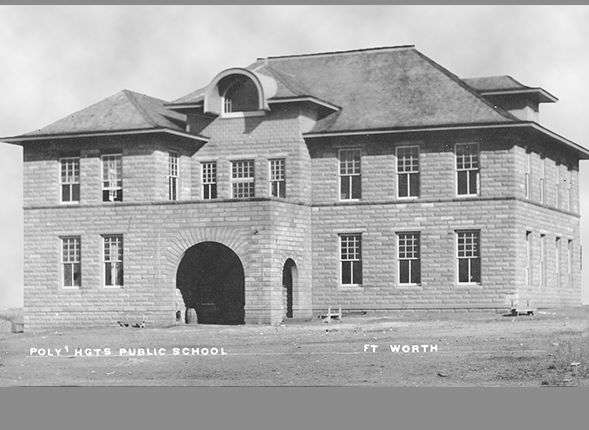
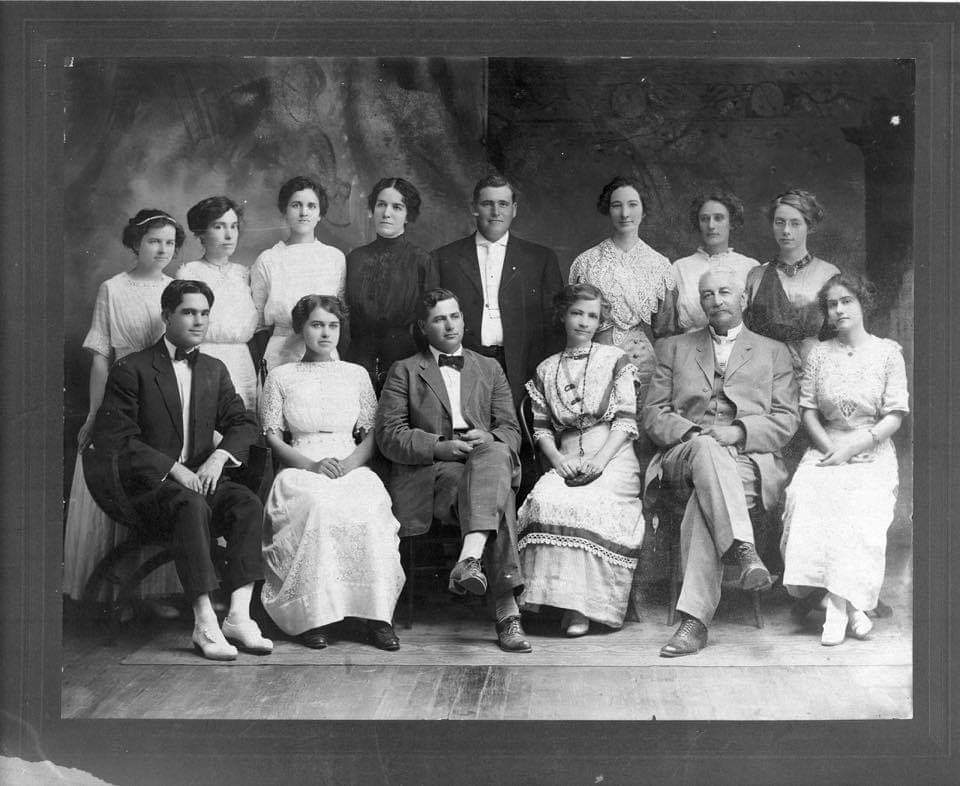
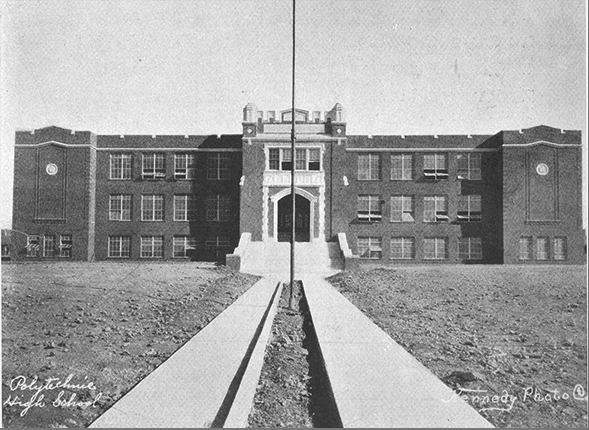
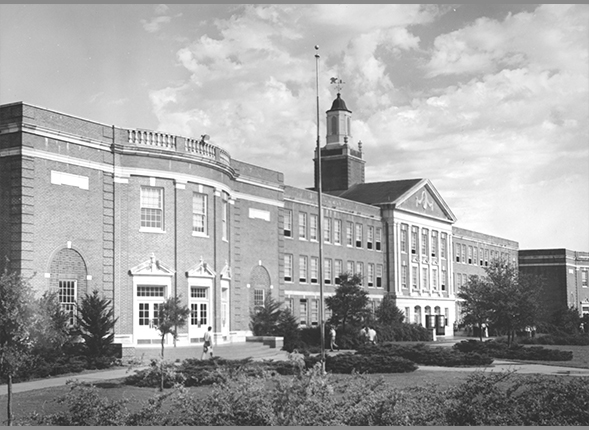
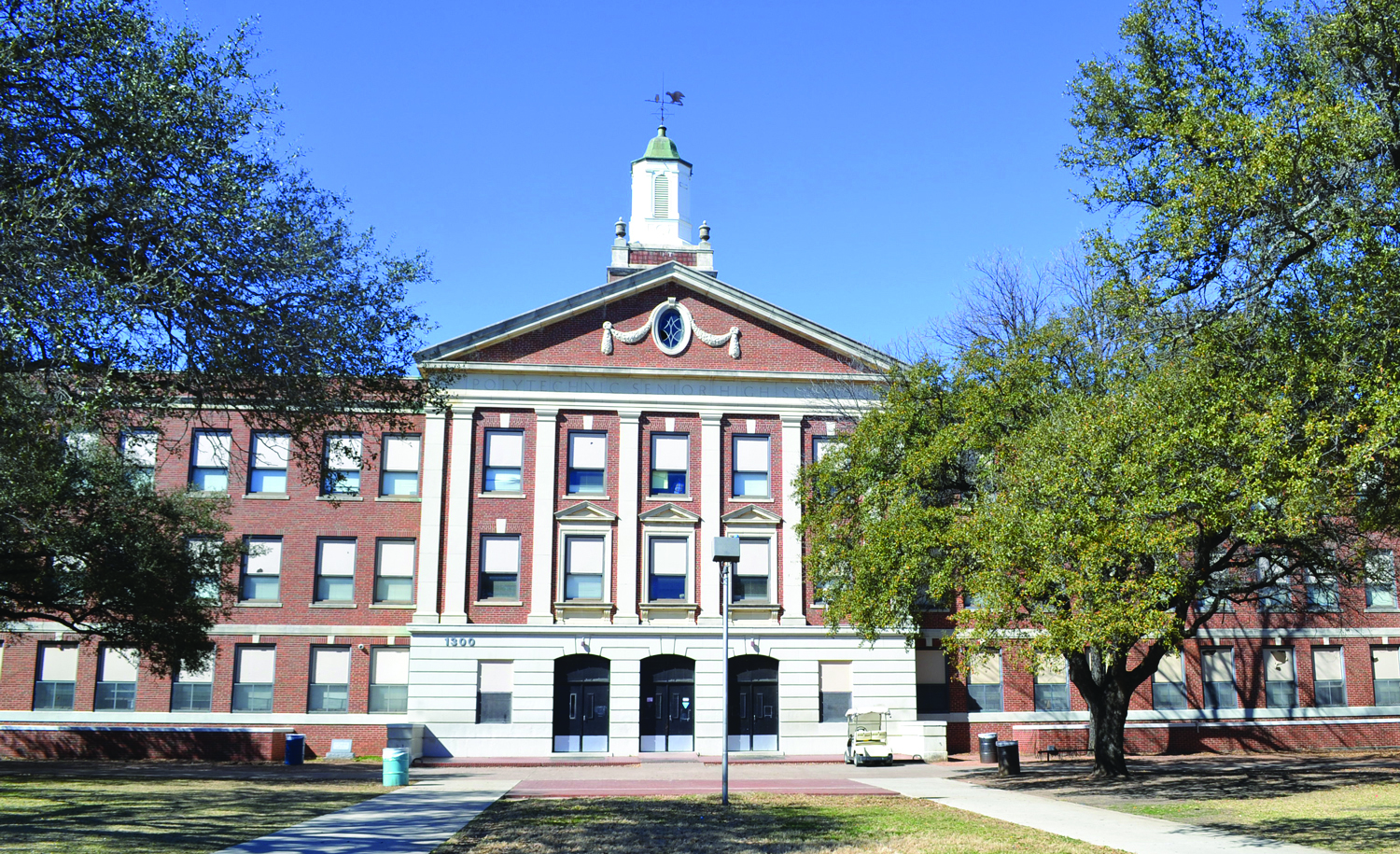
Original song for Poly High School:
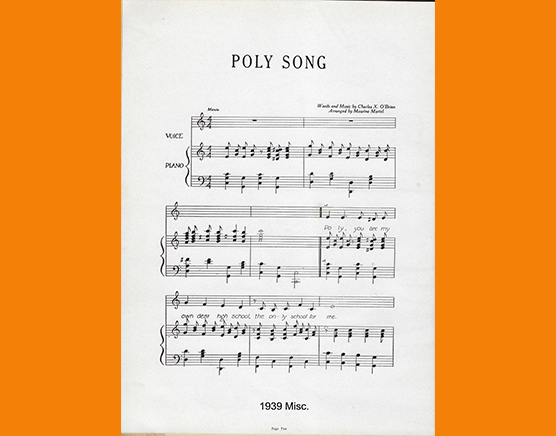
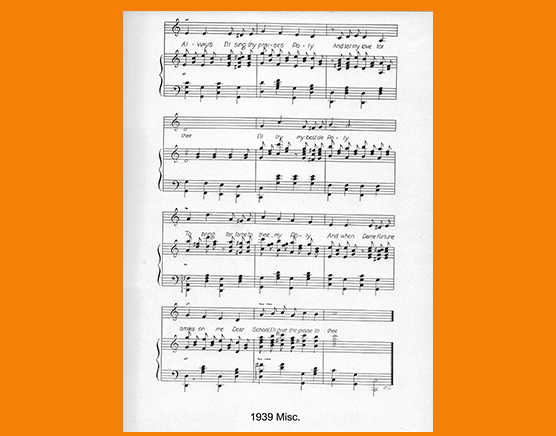
Written by Perry A Sandifer, Poly Band Director in the mid 1940s, performed by the 1952 Poly High School Band members:
Solos by:
George Burns on Saxaphone
Jimmy Coffee on Trumpet
Richard Armstrong on Trombone.
Click the play ▶ button on the control panel below to start listening to the music.
August 1, 1910 - February 15, 2009.
Perry graduated from Decatur High School in 1926 and received a full scholarship from Texas Christian University. He earned bachelor's and master's degrees in both foreign language and music from TCU.
He played trombone in the Fort Worth Symphony and the Fort Worth Opera Orchestras. He was band director in Bangs and Harlingen and directed the Arlington Heights and Polytechnic high schools' bands in Fort Worth.
He was coordinator of music for many years for the Fort Worth Independent School District, during which he organized the All City Orchestra and Chorus and helped coordinate the Van Cliburn competitions.
The First Chair of America recognized the Polytechnic Marching 100 as the Nations top high school band for the school year Sept 1, 1957 thru May 31, 1958. The Marching 100 was selected from among 480 other bands who competed for this prestegious award, throughout the nation.